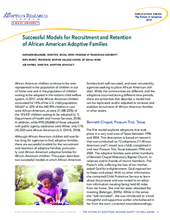African American children continue to be overrepresented in the population of children in out of home care and in the population of children waiting to be adopted in the nation’s child welfare system. In 2017, while African American children accounted for 14% of the U.S. child population, 100,607 or 23% of the 442,995 children in care were African American, as were 27,388 (22%) of the 123,437 children waiting to be adopted (U. S. Department of Health and Human Services, 2018). In addition, while 49% (28,868) of those adopted with public agency assistance were White, only 17% (10,332) were African American (U.S. DHHS, 2018).
Although African American children still wait far too long for agencies to find adoptive families, there are successful models for the recruitment and retention of adoptive families, particularly rural African American adoptive families for African American children. This paper describes two successful models in which African American families both self-recruited, and were recruited by agencies seeking to place African American children. While the communities are different, and the adoptions occurred during different time periods, there are similarities that describe a model that can be replicated and/or adjusted to increase and stabilize recruitment of African American families in other states.

